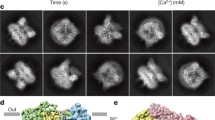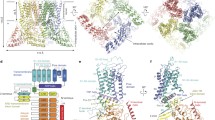Abstract
The transient receptor potential channel TRPV5 contributes to the apical entry pathway for transcellular calcium reabsorption in the kidney. Acid load causes hypercalciuria in animals and humans. We have previously reported that intracellular protons directly inhibit TRPV5. Here, we examined the effects of intracellular pH on single-channel activity of TRPV5. We found that TRPV5 channels exhibit full and subconductance open states in excised inside–out patches of Chinese hamster ovary cells. The slope conductance values (Na+ as a charge carrier, between −25 and −75 mV) for full and subconductance opening at intracellular pH 7.4 were 59 ± 6 and 29 ± 3 pS, respectively. Intracellular acidification caused a small decrease in single-channel conductance. Importantly, intracellular acidification decreased open probability for the full and subconductance states and increased probability for closing. To investigate how intracellular protons decrease open probability of the channel, we proposed a simple three-state model for open–subconductance–closed state transition and examined the effects of acidification on the respective forward and reverse rate constants. We found that intracellular acidification decreases opening of TRPV5 predominantly by promoting a transition from the subconductance to the closed state. Thus, intracellular acidification directly inhibits TRPV5 by causing a conformational change(s) leading to a decrease of open probability of TRPV5 as well as of the single-channel conductance.







Similar content being viewed by others
References
Breslau NA, Brinkley L, Hill KD, Pak CYC (1988) Relationship between animal protein-rich diet to kidney stone formation and calcium metabolism. J Clin Endocrinol Metab 66:140–146
Clapham DE (2003) TRP channels as cellular sensors. Nature 426:517–524
Friedman PA, Gesek FA (1995) Cellular calcium transport in renal epithelia: measurement, mechanisms, and regulation. Physiol Rev 75:429–471
Hille B (2001) Ion channels of excitable membranes. Sinauer Associates, Sunderland, MA
Hoenderop JG, van der Kemp AW, Hartog A, van de Graaf SF, van Os CH, Willems PH, Bindels RJ (1999) Molecular identification of the apical Ca2+ channel in 1, 25-dihydroxyvitamin D3-responsive epithelia. J Biol Chem 274:8375–8378
Hoenderop JG, Nilius B, Bindels RJ (2002) Molecular mechanism of active Ca2+ reabsorption in the distal nephron. Annu Rev Physiol 64:529–549
Hoenderop JG, Voets T, Hoefs S, Weidema F, Prenen J, Nilius B, Bindels RJ (2003) Homo- and heterotetrameric architecture of the epithelial Ca2+ channels TRPV5 and TRPV6. EMBO J 22:1–10
Huang C-L (2004) The transient receptor potential superfamily of ion channels. J Am Soc Nephrol 15:1690–1699
Jordt SE, McKemy DD, Julius D (2003) Lessons from peppers and peppermint: the molecular logic of thermosensation. Curr Opin Neurobiol 13:487–492
Lambers TT, Oancea E, de Groot T, Topala CN, Hoenderop JG, Bindels RJ (2007) Extracellular pH dynamically controls cell surface delivery of functional TRPV5 channels. Mol Cell Biol 27:1486–1494
Lee J, Cha S-K, Sun T-J, Huang C-L (2005) PIP2 activates TRPV5 and releases its inhibition by intracellular Mg2+. J Gen Physiol 126:439–451
Leung Y-M, Zeng W-Z, Liou H-H, Solaro CR, Huang C-L (2000) Phosphatidylinositol 4,5-biphosphate and intracellular pH regulate ROMK1 potassium channel via separate but interrelated mechanisms. J Biol Chem 275:10182–10189
Montell C, Birnbaumer L, Flockerzi V, Bindels RJ, Bruford EA, Caterina MJ, Clapham DE, Harteneck C, Heller S, Julius D, Kojima I, Mori Y, Penner R, Prawitt D, Scharenberg AM, Schultz G, Shimizu N, Zhu MX (2002) A unified nomenclature for the superfamily of TRP cation channels. Mol Cell 92:229–231
Nijenhuis T, Renkema KY, Hoenderop JG, Bindels RJ (2006) Acid-base status determines the renal expression of Ca2+ and Mg2+ transport proteins. J Am Soc Nephrol 17:617–626
Peng JB, Chen XZ, Berger UV, Vassilev PM, Tsukaguchi H, Brown EM, Hediger MA (1999) Molecular cloning and characterization of a channel-like transporter mediating intestinal calcium absorption. J Biol Chem 274:22739–22746
Rohacs T, Lopes CM, Michailidis I, Logothetis DE (2005) PI(4,5)P2 regulates the activation and desensitization of TRPM8 channels through the TRP domain. Nat Neurosci 8:626–634
Sutton RA, Wong NL, Dirks JH (1979) Effects of metabolic acidosis and alkalosis on sodium and calcium transport in the dog kidney. Kidney Int 15:520–533
Vennekens R, Prenen J, Hoenderop JGJ, Bindels RJM, Droogmans G, Nilius B (2001a) Pore properties and ionic block of the rabbit epithelial calcium channel expressed in HEK 293 cells. J Physiol 530:183–191
Vennekens R, Prenen J, Hoenderop JG, Bindels RJ, Droogmans G, Nilius B (2001b) Modulation of the epithelial Ca2+ channel ECaC by extracellular pH. Pfluegers Arch 442:237–242
Yeh B-I, Sun T-J, Lee JZ, Chen H-H, Huang C-L (2003) Mechanism and molecular determinant for regulation of rabbit transient receptor potential type 5(TRPV5) channel by extracellular pH. J Biol Chem 278:51044–21052
Yeh B-I, Kim YK, Jabbar W, Huang C-L (2005) Conformational changes of pore helix coupled to gating of TRPV5 by protons. EMBO J 24:3224–3234
Yeh B-I, Yoon J, Huang C-L (2006) On the role of pore helix in regulation of TRPV5 by extracellular protons. J Membr Biol 212:191–198
Acknowledgement
This study was supported by grants from the National Institutes of Health (DK-20543) and American Heart Association (0440019N). C.-L. H. holds the Jacob Lemann Professorship in Calcium Transport at the University of Texas Southwestern Medical Center.
Author information
Authors and Affiliations
Corresponding author
Additional information
Seung-Kuy Cha and Wasey Jabbar contributed equally to this work.
Rights and permissions
About this article
Cite this article
Cha, SK., Jabbar, W., **e, J. et al. Regulation of TRPV5 Single-Channel Activity by Intracellular pH. J Membrane Biol 220, 79–85 (2007). https://doi.org/10.1007/s00232-007-9076-2
Received:
Accepted:
Published:
Issue Date:
DOI: https://doi.org/10.1007/s00232-007-9076-2




